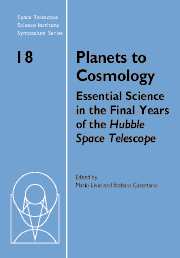 Planets to Cosmology
Planets to Cosmology Book contents
- Frontmatter
- Contents
- Participants
- Preface
- Hubble's view of transiting planets
- Unsolved problems in star formation
- Star formation in clusters
- HST abundance studies of low metallicity stars
- Physical conditions and feedback: HST studies of intense star-forming environments
- Quasar hosts: Growing up with monstrous middles
- Reverberation mapping of active galactic nuclei
- Feedback at high redshift
- The baryon content of the local intergalactic medium
- Hot baryons in supercluster filaments
- Galaxy assembly
- Probing the reionization history of the Universe
- Studying distant infrared-luminous galaxies with Spitzer and Hubble
- Galaxies at z ≈ 6–i′-drop selection and the GLARE Project
- The Hubble Ultra Deep Field with NICMOS
Star formation in clusters
Published online by Cambridge University Press: 17 August 2009
- Frontmatter
- Contents
- Participants
- Preface
- Hubble's view of transiting planets
- Unsolved problems in star formation
- Star formation in clusters
- HST abundance studies of low metallicity stars
- Physical conditions and feedback: HST studies of intense star-forming environments
- Quasar hosts: Growing up with monstrous middles
- Reverberation mapping of active galactic nuclei
- Feedback at high redshift
- The baryon content of the local intergalactic medium
- Hot baryons in supercluster filaments
- Galaxy assembly
- Probing the reionization history of the Universe
- Studying distant infrared-luminous galaxies with Spitzer and Hubble
- Galaxies at z ≈ 6–i′-drop selection and the GLARE Project
- The Hubble Ultra Deep Field with NICMOS
Summary
The Hubble Space Telescope is very well tailored for observations of extragalactic star clusters. Obvious reasons are HST's ability to recognize clusters as extended objects and measure sizes out to distances of several Mpc. Equally important is the wavelength range offered by the instruments on board HST—in particular the blue and near-UV coverage—which is essential for age-dating young clusters. HST observations have helped establish the ubiquity of young massive clusters (YMCs) in a wide variety of star-forming environments, ranging from dwarf galaxies and spiral disks to nuclear starbursts and mergers. These YMCs have masses and structural properties similar to those of old globular clusters in the Milky Way and elsewhere, and the two may be closely related. Several lines of evidence suggest that a large fraction of all stars are born in clusters, but most clusters disrupt rapidly and their stars disperse to become part of the field population. In most cases studied to date, the luminosity functions of young cluster systems are well fit by power laws dN(L)/dL ∝ L−α with α ≈ 2, and the luminosity of the brightest cluster can (with few exceptions) be predicted from simple sampling statistics. Mass functions have only been constrained in a few cases, but appear to be well approximated by similar power laws. The absence of any characteristic mass scale for cluster formation suggests that star clusters of all masses form by the same basic process, without any need to invoke special mechanisms for the formation of “massive” clusters. It is possible, however, that special conditions can lead to the formation of a few YMCs in some dwarfs where the mass function is discontinuous. […]
- Type
- Chapter
- Information
- Planets to CosmologyEssential Science in the Final Years of the Hubble Space Telescope: Proceedings of the Space Telescope Science Institute Symposium, Held in Baltimore, Maryland May 3–6, 2004, pp. 35 - 56Publisher: Cambridge University PressPrint publication year: 2006
- 10
- Cited by
